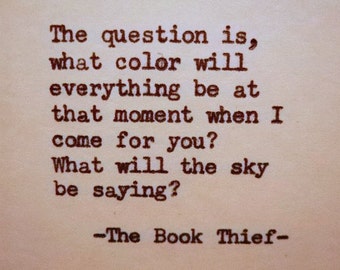Quick test :
Most people these days recognize that colours often symbolize a different idea or emotion. If we look at literature for example: the initial pink coloured conch in The Lord of the Flies could represent innocence, Lady Macbeth’s bloody red hands represents her guilt and the colour gold in The Great Gatsby represents both wealth and death. In the Book Thief, Markus Zusak description of characters and the surrounding’s atmosphere consistently consists of colours. Thanks to the BourneCreative site I was able to somewhat interpret the meaning of certain colours used while I was reading the book.

Source: tealzeh.deviantart.com
After learning that Death is the narrator, we are also introduced to his favourite habit of looking up at the sky during his job of collecting souls. In Death’s eye however, the resulting colour of the sky is dependent on the person who is dying. One example is when Liesel’s brother dies on the train and Death describes the sky as a “blinding kind of white“. A possible reason for Death to see this is because white is commonly associated with pureness. Liesel’s brother who died at a young age could be seen as an innocent child. Other colours our narrator uses to describe the sky he/she(I’m leaning towards the he) sees are black – possibly to representative evil over the holocaust period? , yellow – represnting the exhilerating feeling during bombings? , blotches of red – ruthlessness of WWII, and Jews- yes he/she described the sky as this colour possibly due to the great amount of Jewish people that died.

Rudy’s lemon hair (from pinterest)
Another place where colours are used is in the description of most characters. When Death describes most of the characters, he distinguishes them by a quality with a unique colour. For example, the first thing Death notices about Hans Hubermann is his silver eyes. While Death distinguishes Hans by this, he describes Hans’s wife Rosa as cardboard-like. Although Hans is described with silver eyes not because he is physically wealthy, but possibly because he is very precious to his adopted daughter Liesel. While Rosa’s grouchy attitude on the outside but good-intentional side on inside could explain why she is described as cardboard- the colour brown. Other examples of characters that are described with colours are Rudy with his lemon coloured hair and the Mayor’s wife with her chalky fingers.
One of the things that I find most interesting is that using colours to describe things is just as effective as using words. Reading through the book, I found myself imagining the images these colours created. If bright colors were described I found there seemed to be a lighter mood and if dark colours were used there seemed to be a sad mood. Overall colours were not only symbols but also a great way to set imagery as well as the atmosphere.

Source: etsy



